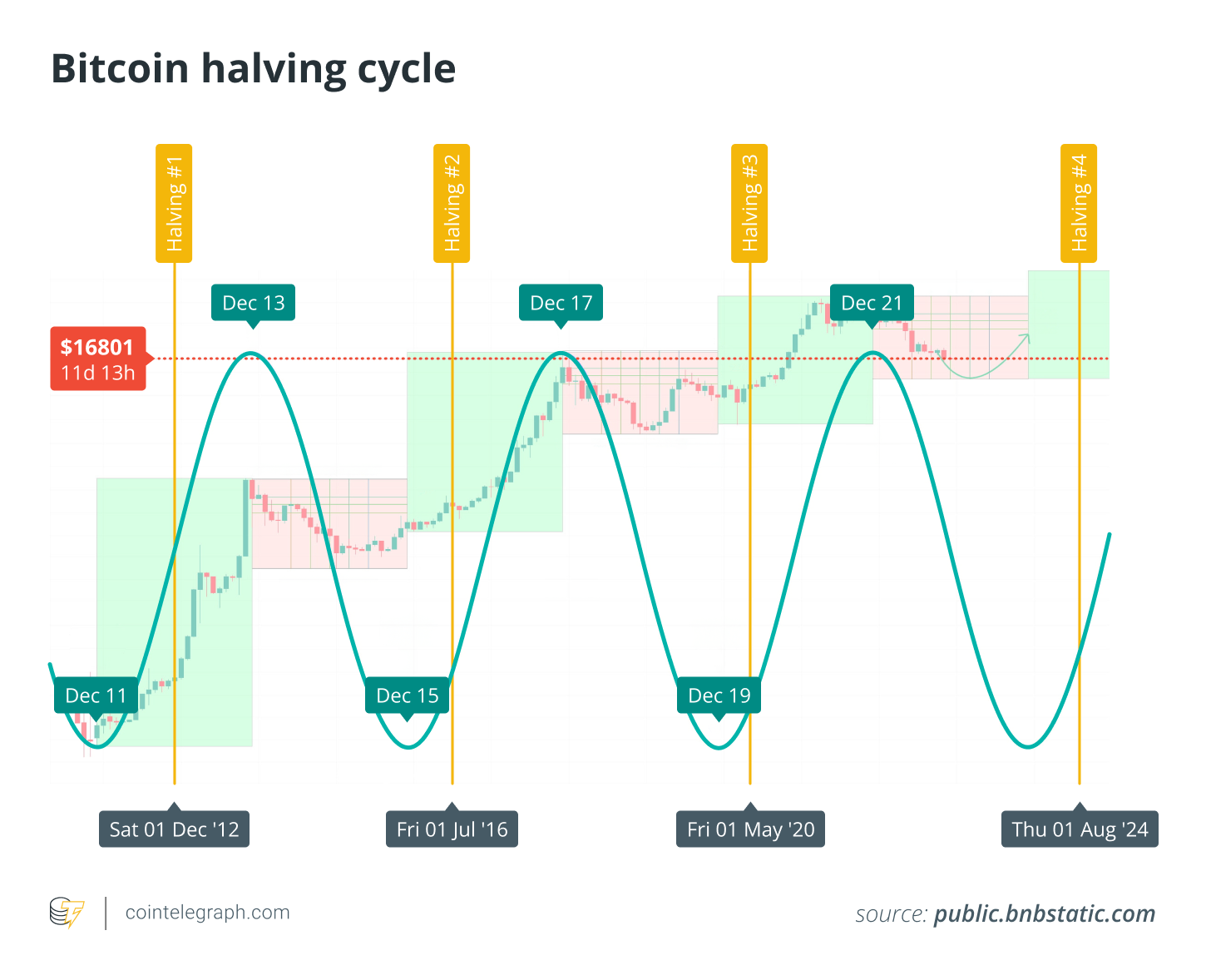2024 is here and that means we are only a few months away from the next Bitcoin halving event.
Past price data suggests that the halving has a dramatic impact on supply versus demand roughly every four years, causing an imbalance that favours long term price appreciation and fuels each bull run.
With several instances of this phenomenon printed right on the BTCUSD price chart, will the halving once again prove to be profitable? Or will the halving fail for the first time ever? Or perhaps something more unique occurs and BTC ETF hype from institutions causes the halving to be front run? Let’s take a look at the many scenarios and how to seize each opportunity.
What is the Bitcoin halving and why does it matter?
The Bitcoin halving is a fundamental aspect of Bitcoin's economic design, occurring approximately every four years (or precisely every 210,000 blocks mined). This event marks a reduction in the rate at which new BTC are generated and released into circulation. Specifically, the halving cuts the reward for mining a new Bitcoin block in half.
When Bitcoin was first created by Satoshi Nakamoto, the block reward was set at 50 Bitcoins per block. This reward remains constant for 210,000 blocks, after which it is halved. There have been three halvings:
-
2012 Halving: The reward decreased from 50 to 25 Bitcoins.
-
2016 Halving: The reward went from 25 to 12.5 Bitcoins.
-
2020 Halving: The reward was further reduced to 6.25 Bitcoins.
The next halving, due in April 2024, will reduce the reward to 3.125 Bitcoins per block.
The halving is important for several reasons:
Controlled supply: One of Bitcoin's fundamental principles is its limited supply - there will only ever be 21 million Bitcoins. Halvings help regulate the pace at which new Bitcoins are created and move towards this finite supply, ensuring that the last Bitcoin won't be mined until about the year 2140. This controlled supply mechanism mimics the extraction of resources like Gold, becoming more scarce and harder to mine over time.
Economic incentives: Initially, high block rewards incentivised miners to secure the network and process transactions. As the block reward diminishes, transaction fees are expected to become the primary incentive for miners. This transition is critical for Bitcoin's long-term security and sustainability.
Impact on Bitcoin's price: Bitcoin halvings have historically been significant events, often correlated with substantial price movements. Many in the Crypto community speculate on the supply-demand economics theory: as new supply reduces while demand remains constant or increases, the price should theoretically rise.
Market sentiment and speculation: Halvings often generate extensive media coverage and community buzz, impacting investor sentiment. This increased attention can lead to speculative rallies leading up to and following the halving event.
Long-term sustainability: The halving is also pivotal for the long-term economic model of Bitcoin. By reducing the block reward, Bitcoin is designed to transition smoothly from an inflationary asset to a deflationary one as it approaches its maximum supply limit. This characteristic is often cited as a hedge against traditional fiat currency inflation.
Miner's revenue and network security: The halving impacts miners' revenue, as their earnings from block rewards are reduced by half. This can lead to a short-term decrease in mining activity as less efficient miners become unprofitable and exit the network. However, historically, the increase in Bitcoin's price post-halving has compensated for the reduced block reward, maintaining the overall security and robustness of the Bitcoin network.
Bitcoin cycles by the numbers: analysing pre- and post-halving profitability
Comparing Bitcoin profitability before and after each halving can help to potentially predict what to expect in 2024 and beyond.
December 2012 Halving:
Pre-Halving: In the 13 months leading up to the halving, Bitcoin's price increased by 560%.
Post-Halving: In the subsequent 12 months, a staggering growth of 9120% was observed.
August 2016 Halving:
Pre-Halving: Over 12 months, a gain of 369% was seen.
Post-Halving: The next 17 months witnessed a 3300% increase in Bitcoin's value.
June 2020 Halving:
Pre-Halving: The 18 months prior saw a 330% increase.
Post-Halving: Bitcoin's value grew by 640% over the following 17 months.
The 2024 Halving Scenario
As of January 17, 2024, Bitcoin has experienced a 207% increase from its bottom, with four months remaining until the next halving. This growth is more conservative compared to the pre-halving surges in previous cycles.
The average increase in Bitcoin's price before past halvings is approximately 420%, making the 2023 and early 2024 run up seem meagre by cycle averages. The average growth following the halvings is about 4353%, suggesting the strongest growth phase has yet to come.
Cryptocurrency cyclical theory alternatives
Bitcoin believers and naysayers alike aren’t all in on the halving theory. Several other theories exist that could suggest that other dynamics are at play when considering what’s driving each Crypto bull market.
For example, the Global M2 YoY% chart above that highlights global liquidity tracks incredibly closely against Bitcoin’s YoY% growth. In this scenario, global liquidity, mostly from China, is what is helping to propel Bitcoin and altcoins higher.
Other theories exist yet. Another example relies on Hurst Cycle Theory, a form of technical analysis published by J.M. Hurst in the 1970s. The study includes the syncing of major bear market troughs. With market bottoms synchronised, market tops tend to appear towards the crest of each cycle.
This unorthodox alternative theory could be pointing to a cycle peak a lot earlier than has occurred in the past. Whether this is driven by recent institutional interest in Bitcoin via spot BTC ETFs, or something else, remains to be seen, if it occurs at all. However, the truth is, no one truly knows what might happen to Bitcoin in the coming months as we approach the halving, making increased speculation the one guarantee.
The top three Crypto platforms for trading
As we approach the Bitcoin halving in 2024, the importance of choosing the right Crypto platform for trading becomes paramount. Binance, ByBit, and PrimeXBT are three leading platforms that stand out in the market, each offering unique features that cater to various trading strategies.
Binance is a globally recognised name in the Cryptocurrency space, known for its extensive range of trading tools, including futures and spot trading. ByBit has established itself as a platform with a strong focus on derivatives trading. It is particularly noted for its perpetual contracts and leveraged trading options, which are essential for traders looking to capitalise on short-term market movements.
PrimeXBT stands out for its innovative approach, especially in the realm of Crypto Futures. PrimeXBT’s leverage and margin trading capabilities are noteworthy, allowing traders to magnify their trading positions amidst the market’s volatility. The platform's unique feature is its ability to hold Bitcoin (as well as ETH, USDT, USDC, etc.) as collateral.
This functionality enables traders to maintain their Bitcoin positions while engaging in derivative trading, offering a blend of long-term holding and active trading. Moreover, the ability to trade derivatives using BTC balance on PrimeXBT streamlines the trading process, allowing for quick and efficient market responses. This is particularly advantageous during the speculative periods surrounding the Bitcoin halving.
While Binance offers a comprehensive Crypto trading ecosystem and ByBit specialises in derivative trading tools, PrimeXBT provides a distinct advantage with its BTC collateral feature, catering to traders seeking both flexibility and efficiency. As the Bitcoin halving draws near, these platforms offer tailored tools and features, enabling traders to navigate and potentially benefit from the expected market volatility and opportunities.
Disclaimer: This article is provided for informational purposes only. It is not offered or intended to be used as legal, tax, investment, financial, or other advice.





